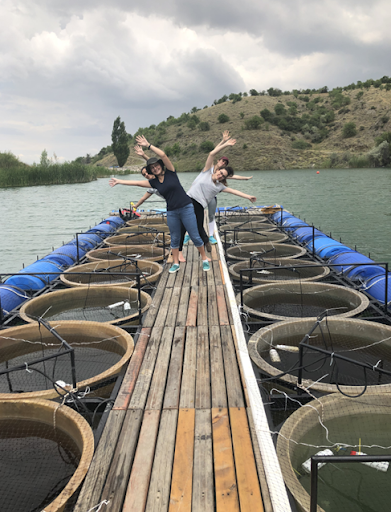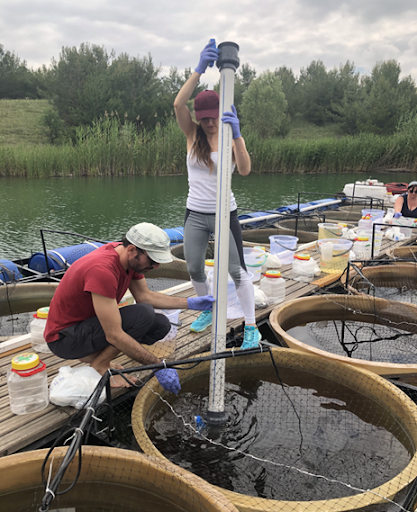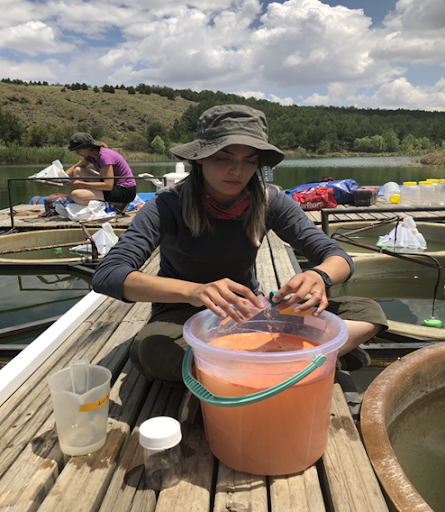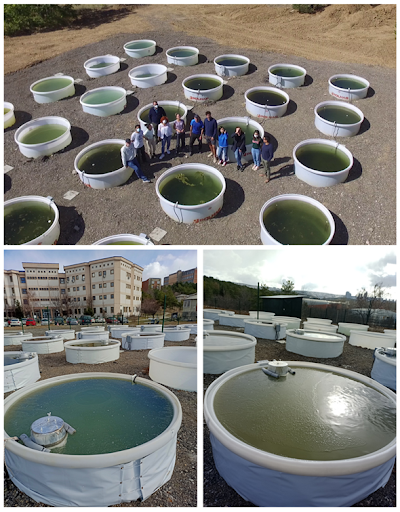Facilities
Transnational Access
Metadata & Data
Papers & Reports
Knowledge Base
METU Mesocosm System
Middle East Technical University (METU)
Infrastructure Description
Description of the infrastructures: At Middle East Technical University, Ankara campus, there are two different mesocosm systems which include in-lake floating system named METU Mesocosm System I (MMS I) and on-land buried system named METU Mesocosm System II (MMS II).
METU Mesocosm System I (MMS I)
This system is in-lake system deployed at METU campus Experimental lake which is in close proximity to the Limnology Laboratory (<1 km). It is a semi-mobile system that can be transferred to other locations by dismantling and it consists of 16 cylindrical (1.2 m diameter) robust fibreglass tanks either in 1.2 m or 2.2 m height. In lake, the upper edges of all mesocosms are attached to pontoon bridges 20 cm above the water surface to avoid incursion of water during windy periods. Eight mesocosm tanks are arranged in two rows for ease of access. The pontoon bridges are wood constructions and the floating devices consist of 32 plastic barrels, each 120 L. It is free floating and anchored only at the platform end, which, irrespective of wind direction, serves as a wave breaker and landing point for boats.
The METU Mesocosm System I offers set-ups of low and high-water levels (1.2 and 2.2 m) and the connection to 10 cm sediment layers (90% (by volume) washed sand (grain size <1 mm) and 10% sediment from a lakes). To simulate shallow, fully mixed lake conditions, the water in the mesocosms is continuously circulated during experiments using electrically powered pumps.




Description of METU Mesocosm System II
METU Mesocosm System II is design to allow researchers to study shallow lake and pond ecosystems ecological structure, functions and diversity under the effects of global grand challenges. Especially MMS II is suitable for studying the effects of salinization on lakes as it is located in in arid Steppe climate where salinization is a major problem.
METU, Mesocosm System II includes 24 mesocosms, with 2m wide and 1.65m in height. They are buried into the ground up to 1m depth and each have 30 cm of sediment (1:1 ratio of washed sand and natural sediment form different lakes). To mimic the presence of wind induced current and prevent thermal stratification, water in each mesocosms is mixed via a pump. Mesocosm System II includes 24 mesocosms, with 2m wide and 1.65m in height. They are buried into the ground up to 1m depth with 30 cm of sediment (1:1 ratio of washed sand and natural sediments from different lakes). To mimic the presence of wind induced current and prevent thermal stratification, water in each mesocosms is mixed via a submersible pump. The mesocosm are fed groundwater.
The system is still under development and we are aiming at equipping some (if not all) of the mesocosms with 1) a programmable, remote controlled electrical heating system, with heating is adjusted in reference to the ambient temperature tanks, sensors for temperature conductivity and dissolved oxygen allowing HF measurements, 3) flow-through-condition with adjustable hydraulic retention time. The mesocosm are arranged in the following configuration and also see the picture. A similar system is established at the Marine Institute in Mersin at the south coast of Turkey.


We are able to measure physicochemical parameters, including water temperature, salinity, electrical conductivity, oxygen, pH, water transparency, alkalinity, suspended solids, color, nutrients (NO3, NO2, NH4, total nitrogen, PO4, and total phosphorus), major ions, and dissolved organic carbon, besides biological communities, such as bacterioplankton, phytoplankton, zooplankton, ciliates, heterotrophic nanoflagellates, periphyton, chlorophyll-a, major photosynthetic pigments, macrophyte cover, fish, and macroinvertebrates as well as metabolism, greenhouse gas emissions (CO2 and CH4), and decomposition.
The Limnology Laboratory, which operates the both METU Mesocosm Systems, is equipped with sampling gear, analytical instruments (e.g. auto-analyser for N, and other nutrient analyses, all kind of microscopes, HPLC, FlowCam, flow-cytometer, sampling gear for water, fish and macrophyte sampling) and a walk-in climate room, METU has a central laboratory facility which is equipped with elemental analyser (particulate C and N analyses), ICP-MS (trace elements analyses), Fourier transform infrared spectrometer (FTIR), as well as modern molecular-biology laboratories.
Facility Description
Organisation Address
Orta Doğu Teknik Üniversitesi (ODTÜ), Middle East Technical University (METU), Üniversiteler Mahallesi
Dumlupınar Bulvarı No:1
Çankaya/Ankara
06800
Turkey
Infrastructure Address
METU Campus
Ankara
Turkey
Information Sources
Location
Gallery
Contacts
Meryem Beklioğlu
Controlled Parameters
water depth and nutrients (both TP and TN)
Research Topics
Role of water level on ecosystem processes (e.g. C and N) as well as impact of food additives (TiO2) on food web structure and ecosystem processes
Experiment Years
2011, 2012, 2018 - present
TA Support
Services currently offered by the infrastructure: The METU Limnology Laboratory offers scientific experience and instruments needed for analyses of nutrients, identification of phytoplankton, zooplankton, macrophytes (see above). Users also get access to METU’s fully equipped central laboratory facility. METU Mesocosm System set-up provide natural opportunities to work on lake water level changes, and consequently water volume changes and salinisation induced through evaporative water loss in two different water depths, for a better understanding of climate change. Each set of low and water level mesocosms (12 each set) can be used separately for different purposes. The set-up allows investigating the effects of drought in relation with eutrophication or toxic chemicals on salinisation, water level change, trophic structure, dynamics, nutrient/toxic chemical balances, organisms from bacteria to fish, metabolism, adaptation and microevolution.
Support offered under AQUACOSM: Users will be given access to the mesocosm facility as well as the full range of laboratories and instrumentation available at the METU Mesocosm System and METU Limnology Lab. This includes physical, logistic, technical and scientific support. AQUACOSM scientific staff and the task leader will further assist users with supervising and training as well as providing assistance throughout the stay.
Support offered under AQUACOSM-plus: All visitors will have access to the full range of laboratories and instrumentation available at the METU Mesocosm System and METU Limnology Lab, physical, logistic, technical and scientific support will be provided. The AQUACOSM-plus Post-Docs and PhDs, and the project leader will further assist the users with running scientific supervision, training and technical assistance throughout the stay.
TA Modality of Access
Modality of access under AQUACOSM: A total of at least 630 person-days will be allocated to external users during years 2-4 of the AQUACOSM Transnational Access provision. A minimum access for 9 persons is envisaged for 20 days each year. External users will be prioritised for using the mesocosms throughout the AQUACOSM TA activities. To maximise scientific output, efforts will be made to integrate the AQUACOSM TA activities into other projects at the facility. Access to the facility by international scientists has already been rewarded by a publication in a leading ecotoxicological journal.
Modality of access under AQUACOSM-plus: A minimum of 500 person-days will be allocated to external users through TA provided under AQUACOSM-plus. It is anticipated that AQUACOSM-plus will support stays of at least 4-5 persons for 65 days per year in M10-21 and M34-45. To maximise the scientific outcome, efforts will be made to integrate the TA activity with other on-going and planned projects at the facility. International collaboration at METU has already produced a high impact factor publication in addition to publication of the REFRESH project. In 2018, an in- situ mesocosm experiment investigating the impact of microplastics on the littoral food web was carried out with 10 students and scientists supported through TA during AQUACOSM. For summer 2019, METU Mesosystem System are participating in the AQUACOSM-JOMEX experiment with 13 TA participants from Europe and Brazil.